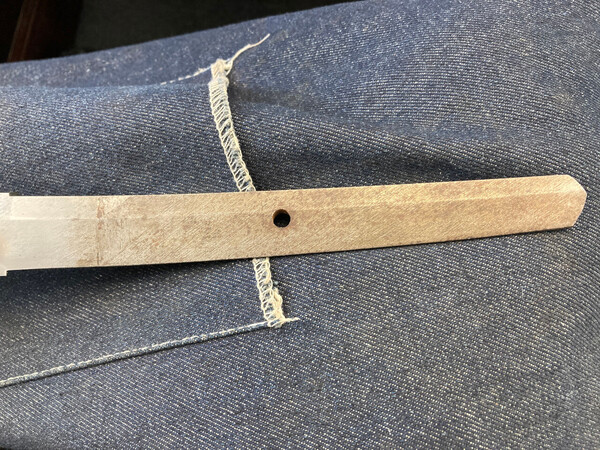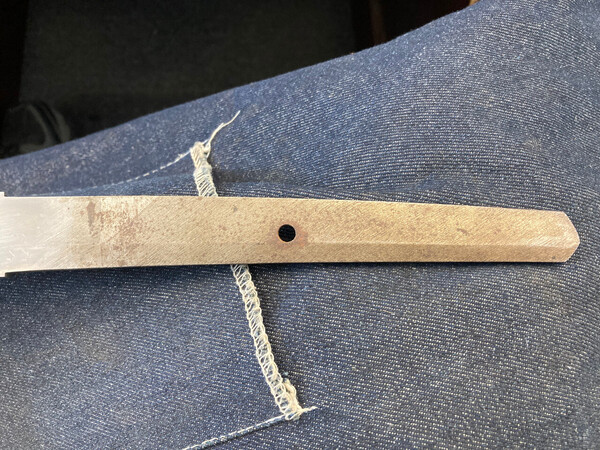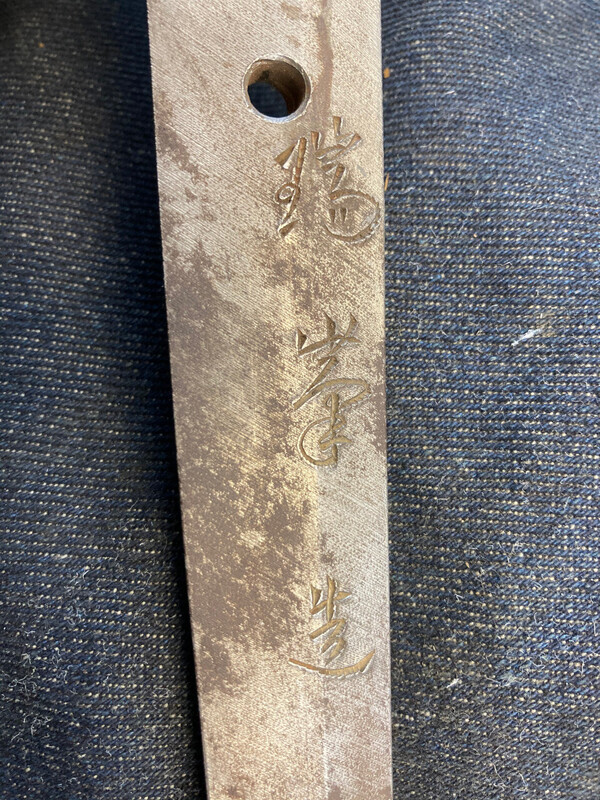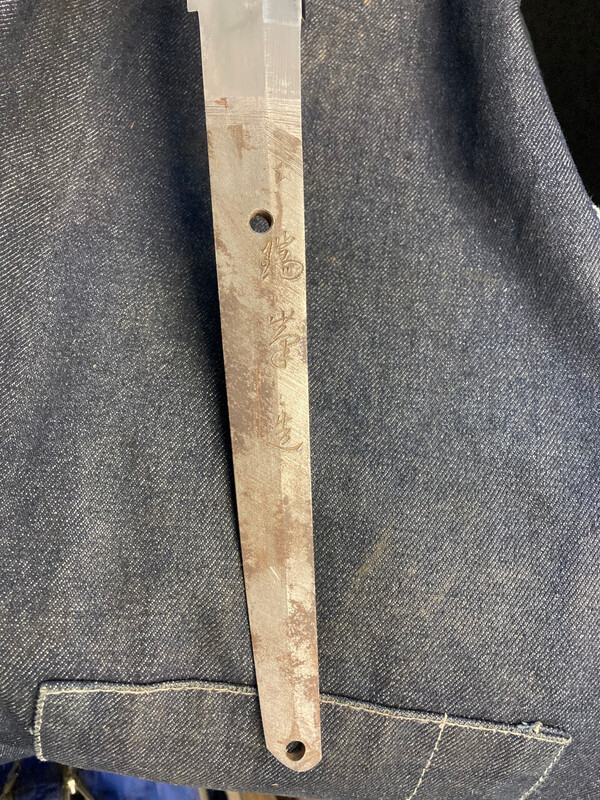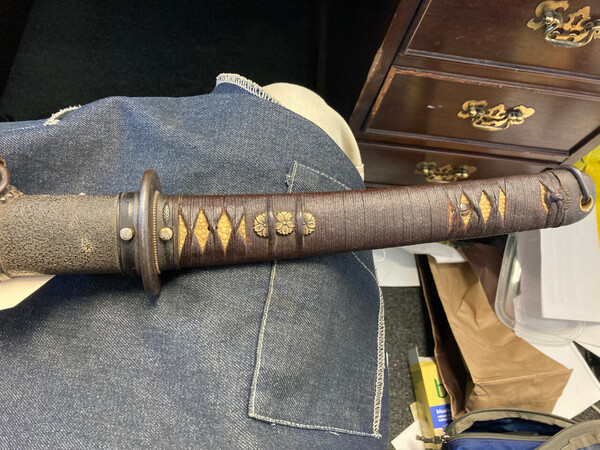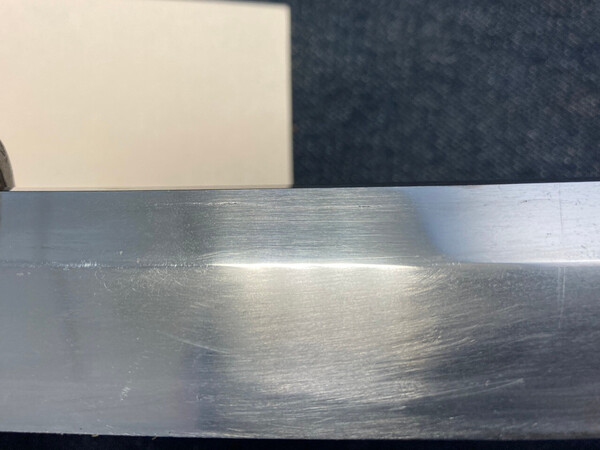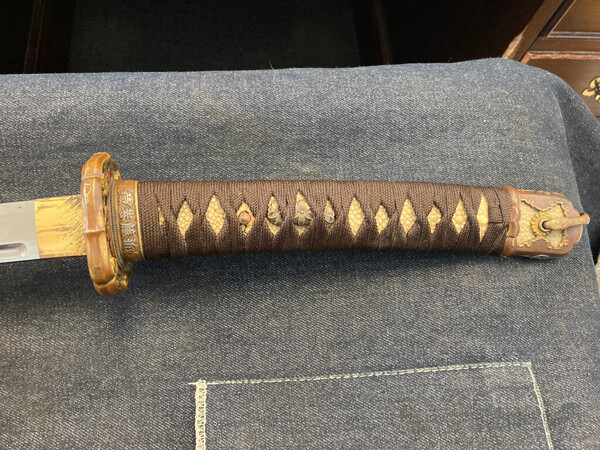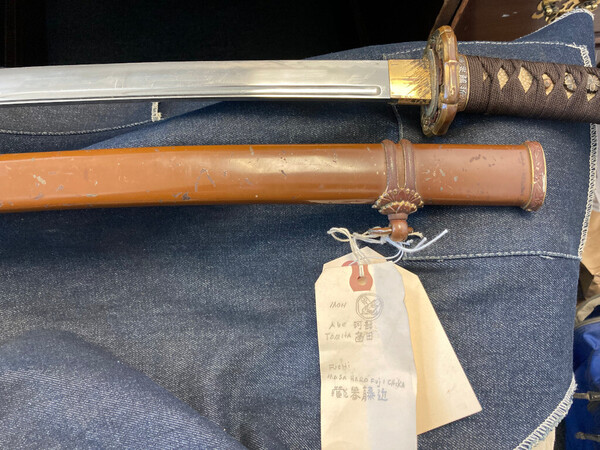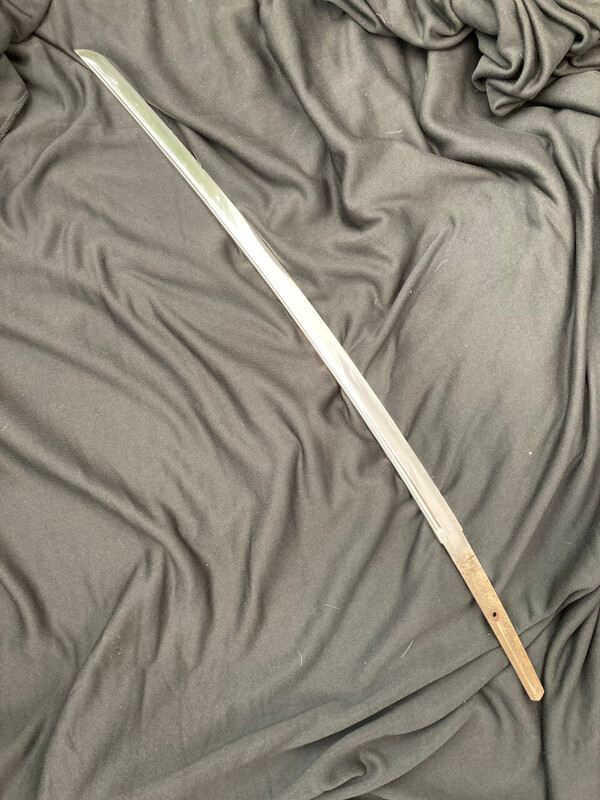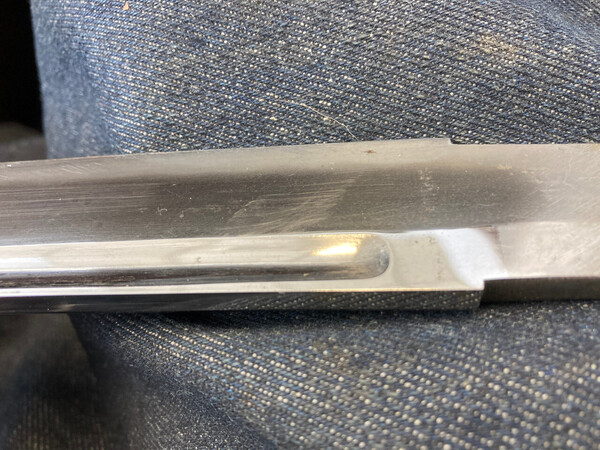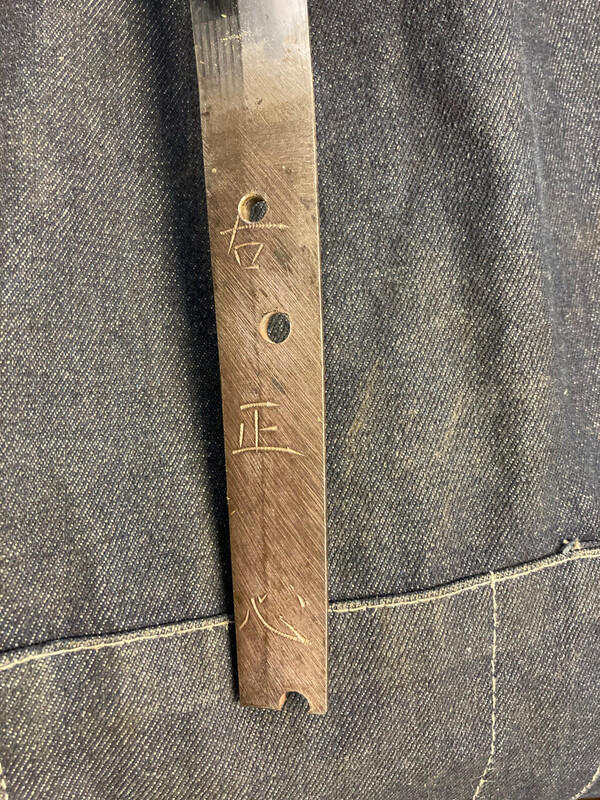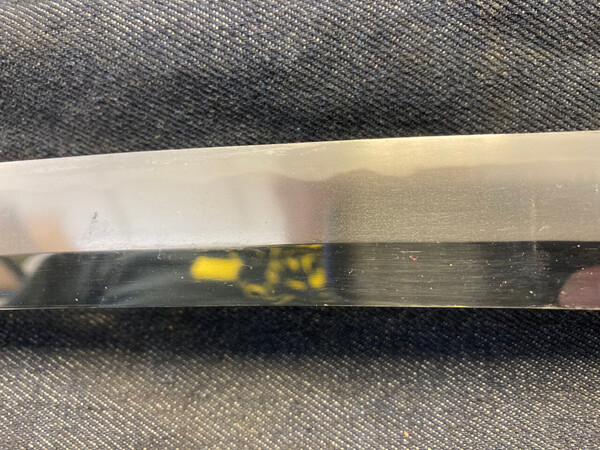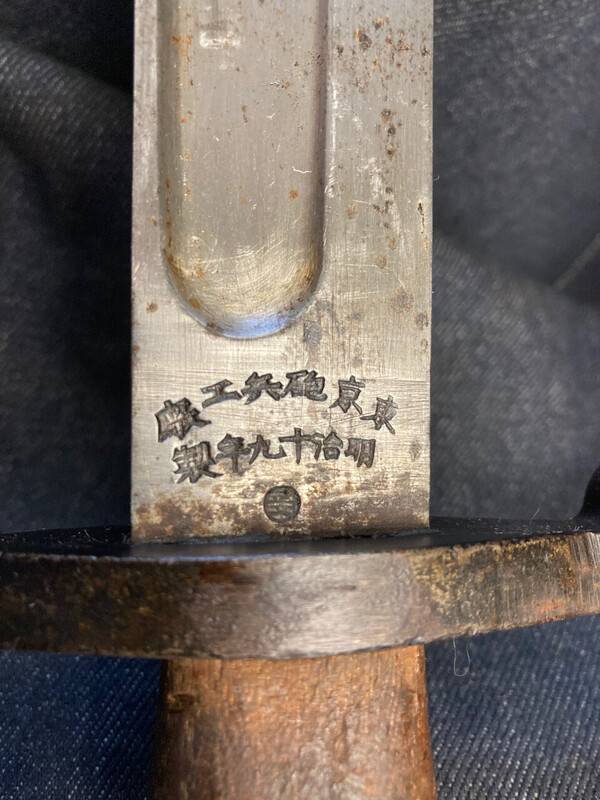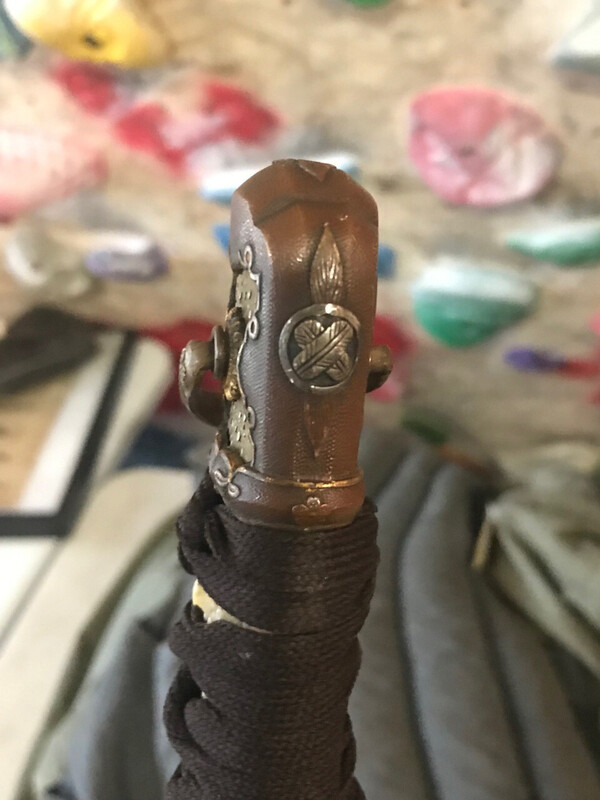
tbonesullivan
Members-
Posts
394 -
Joined
-
Last visited
Content Type
Profiles
Forums
Events
Store
Downloads
Gallery
Everything posted by tbonesullivan
-
A friend of mine heard that I can "read Japanese on swords", so he gave me this Kogatana from a tanto setting he has to look at. I'm fairly certain the Kanji are 国 善 定 兼 門, however my knowledge of actual Japanese is 1 year of college Japanese about 20 years ago. KUNI YOSHI SADA KANE HIRO? I'm going to assume that it is a name, but many of those characters can be read in multiple ways. The last character alone could be MON, HIRO, KADO or possibly other things.
-
Thanks! Looks like there were three generations, with various different MEI, though none match exactly what I have. Hopefully NYTK can start having in person meetings again later this year, so maybe I could have someone look at it first hand, and not at my horrible pictures.
-
Oh wow! Thanks! It's got a 21 inch blade, so it's a Wakizashi. I wish the polish was in better shape. Came mounted in Type 98 Shin-Gunto fittings, with a leather covered scabbard, like several other older blades I've seen. Time for the researching. It doesn't look like it's been Shortened.
-
Another day, another Mei with that ONE character I can't get. I'm certain about the beginning, which is 筑 前 住 源 信 国 吉 or 筑 前 住 源 信 國 吉, depending on which form of "KUNI" I use. I found more with the second one way of writing it, though it is definitely 国 on the tang. So it would read CHIKUZEN JU MINAMOTO NOBUKUNI YOSHI ??? However, I found nothing on the last character. Most MEI I can find want the smith's name to end with 吉包 YOSHIKANE or 吉貞 YOSHISADA. That character looks like 枚 MAI or something else. I'm at a loss. The other characters are quite easy to read.
-
Help Requested for 4 Kanji on Fuchi
tbonesullivan replied to tbonesullivan's topic in Translation Assistance
Here's a close up of the tang file marks. I also used my 16x magnifier on the hamon, which is a NOTARE / wave shape. I can see Nie along the transition, and there is some activity. -
Definitely looks like MUNE. 宗 . I often get it confused with 京 KYO
-
Help Requested for 4 Kanji on Fuchi
tbonesullivan replied to tbonesullivan's topic in Translation Assistance
I'm going to try to get a better look and picture of the Hamon. I'm pretty sure it's got Nie crystals along the edge, I've pulled Type 95 NCO blades before, and this shows no signs of being one. This is one I'd love to be able to bring into a NYC Token Kai meeting, but right as I was about to go to my first meeting COVID came knocking. -
Thanks so much! "Grass Writing", well at least now I know the name of my pain. Yes it looks great, but I can't read it, any more than I can read 18th and 19th century letters written by quill. Some are easy, some are unintelligible. I haven't had any "Type 3" swords before, so this is pretty nice. We also got another signed 長 光 作 NAGAMITSU SAKU.
-
I've been having trouble with this one for a few weeks. It's got a somewhat "flowing" more script style of writing, which is something I'm bad at. The best I could come up with the MEI and the RJT list is 昭幸造 , or AKI YUKI TSUKURU, but I'm not sure about that at all. The other side looks to have a Nengo in Zodiac form, which I am pretty sure about: 癸 未 八 月 - MIZUNOTO HITSUJI 8th Month - 1943. But the Getsu character looks a bit off, and there's no Era marking. The blade is pretty long on this one, with a Nagasa 69.4 cm long. The tang has the "Star" marking, which I believe means it is Gendaito. Unfortunately the blade has been cleaned a bunch, probably post war, so I can't see much, but it does have WARE on the SHINOGI-JI.
-
Help Requested for 4 Kanji on Fuchi
tbonesullivan replied to tbonesullivan's topic in Translation Assistance
Oh, I wasn't implying that at all. It was a good material for the time, but over time it can decompose. I also don't know if all used nitrocellulose, as most may have been cellulose acetate, which is much more stable. I've only seen the decomposition a few times on blades, so I would assume most were not nitrocellulose. They still use Nitrocellulose on very high end guitars to this day, saying it sounds better. I just like the look of the real ray skin over the celluloid. -
Help Requested for 4 Kanji on Fuchi
tbonesullivan replied to tbonesullivan's topic in Translation Assistance
Yeah, it's not the usual color, and definitely not the same material I'm used to seeing. The ray skin looks like it is real though, and not the plastic stuff. I've seen the nitrocelluloid faux ray skin decompose, which caused the wrapping to turn red and disintegrate, and the wood started crumbling too. Reminds me of when they find old guitars from the 50s, kept carefully in the cases, and the nitrocelluloid pickguard decomposed and pretty much destroyed everything. -
Help Requested for 4 Kanji on Fuchi
tbonesullivan replied to tbonesullivan's topic in Translation Assistance
It's mumei. There's not a single marking on it, and I went up and down with a magnifying glass to see if anything was on the spine of the tang. It's got a pretty nice temper line, and the BO-HI, so I was expecting a signature. -
Shin Gunto Mei translation help
tbonesullivan replied to PNSSHOGUN's topic in Translation Assistance
Oh nice! I wish I'd known what to look for with all the Shin-Gunto I've had to look at. Originally we would just say "signed" and never bothered to identify the dates, makers, and keep track of the Arsenal stamps. I can say that overall Seki and Showa are the two most common ones I have seen first hand. Now if only I could reliably identify Kanji besides numbers, MASA, KANE, MITSU, and ISHI. -
Help Requested for 4 Kanji on Fuchi
tbonesullivan replied to tbonesullivan's topic in Translation Assistance
Sure! It's pretty typical Shin-Gunto, though the scabbard has a gloss finish, not matte. Also the Tsuba is perforated / skeletal. -
Help Requested for 4 Kanji on Fuchi
tbonesullivan replied to tbonesullivan's topic in Translation Assistance
I only the blade was as interesting as the fittings! It does have a Bo-Hi, and a temper line, but the blade is definitely Showato and the tang is unmarked. Not even an arsenal marking. It's also got some edge damage, hopefully from service during wwii. -
Help with Mei Shin-Gunto with Cut tang. 石 正 心?
tbonesullivan replied to tbonesullivan's topic in Translation Assistance
Whoa! thanks! Shoulda searched the kanji "右正心" before posting. I'm wondering why it was cut down. Seems to have been refit once or twice maybe. It's in standard textbook Type 98 Shin-gunto fittings with an Aluminum scabbard. -
So, this is a blade from a Type 98 Shin gunto setting. The blade is actually in pretty good polish. The tang was cut down, but it also doesn't look very old, so I'm thinking the blade is definitely Showa Era. The mei is a bit strange. The first two characters are 石 正 ISHI MASA, and the last one, as far as I can tell, is 心 SHIN. I've been looking can't cant find anything, so I'm wondering if my translation is correct and/or incomplete. Maybe there was another character that got cut? off? Any help would be appreciated!
-
It weighs 1.65lbs according to my scale, and it's 26 inches long with a 21 1/4 inch blade. Nice substantial feel, but not as heavy as say a U.S. Civil War Artillery short sword. Those are pretty beastly. I've also seen that with some Swiss and Italian bayonets for the Vetterli rifles. I've always wondered how well it worked out over all in terms of durability. I've seen various "bolo" machetes used by the U.S. that also have the blades ground from only one side.
-
Well, this is definitely a weird one. At first I thought it was some type of WWI/WWII era Chinese Jian, and it's dated on the blade. However, after looking through Chinese era dates fruitlessly, I though the era date looked familiar. Well, it should, as this sword, real or not, has a Meiji Date on it. It's dated right to left, but it definitely reads 明 治 十 九 年 or Meiji 19 = 1886. This would be well after the Satsuma rebellion and into the "modernization" of Japan. Has anyone seen one of these before? The blade is flat on one side, and fullered on the other, and honestly looks like a Western style artillery short sword. Google is failing me. Was Japan making export swords at the time? It definitely is well made, but also definitely machine made.
-
Help Requested for 4 Kanji on Fuchi
tbonesullivan replied to tbonesullivan's topic in Translation Assistance
Oh wow, I never thought there'd be any information about him. Is there any meaning to the Mon other than the link to many famous Samurai families? I've seen the same mon on various other Shin-Gunto swords. -
Well, this is a Shin-Gunto with what looks to be a Maruni chigai takanoha (丸に違鷹羽) Mon on the Kabuto-gane. It also has 4 Characters on the Fuchi, which are giving my rudimentary Japanese skills fits. The one farthest to the right looks like 近, but it seems to have an extra stroke. I checked the list of 8 stroke kanji I have, but couldn't find anything. The others I have no clue on.






